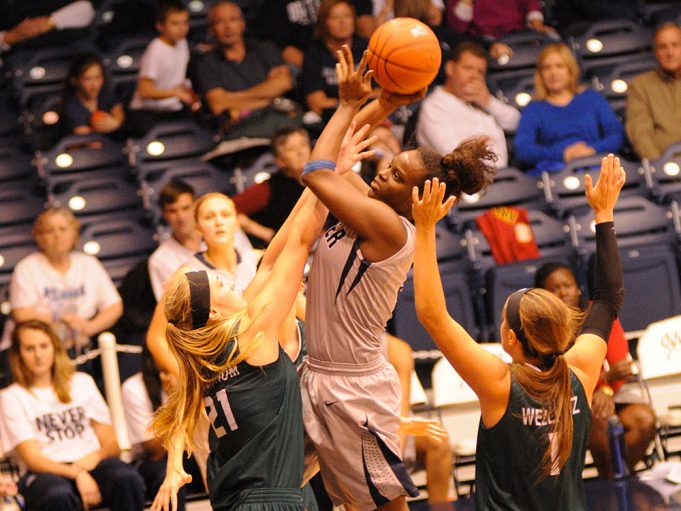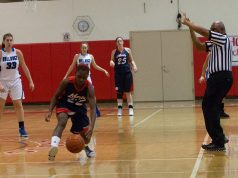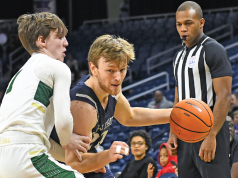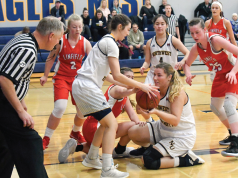“Two shots,” or “Going up!” Terms that are not used often enough. What many hear more often is, “No, on the floor!”
Ask yourself what “on the floor” means regarding the rules of continuous motion. You may be surprised to learn that the common practice to use such a phrase, “on the floor,” is not supported by rule. In fact, it contradicts the rules relating to continuous motion.
Continuous motion is defined in NFHS rule 4-11 as follows:
Art 1: Continuous motion applies to a try or tap for field goals and free throws, but it has no significance unless there is a foul by any defensive player during the interval which begins when the habitual throwing movement starts a try or with the touching on a tap and ends when the ball is clearly in flight.
Art 2: If an opponent fouls after a player has started a try for goal, he or she is permitted to complete the customary arm movement, and if pivoting or stepping when fouled, may complete the usual foot or body movement in any activity while holding the ball. These privileges are granted only when the usual throwing motion has started before the foul occurs and before the ball is in flight.
Art 3: Continuous motion does not apply if a teammate fouls after a player has started a try for goal and before the ball is in flight. The ball becomes dead immediately.
In other words, the true determining factor in ruling to award free throws or not is what the player is doing at the time of the foul. The player is doing one of three things: dribbling, passing or shooting.
It is easiest when the player is dribbling while being fouled. In that case, the player can’t be awarded free throws, as they haven’t started a try.
Once you determine the player has ended his or her dribble, that player is either attempting to pass or shot. When fouled you need to judge which of the two the player was doing.
If you can’t determine that the player is passing the ball, how can we know that the player wasn’t attempting to shoot? The ball does not need to be in flight for the proper awarding of continuous motion and free throws. Many fouls are made by players who are fouling to deny the player from getting the shot attempt off.
Remember the definition for when a try begins in 4-41-3: The try starts when the player begins the motion which habitually precedes the release of the ball.
Have a patient whistle and see the play all the way through
Therefore a player can indeed, by rule, begin a shot while still on the floor. In fact, every shooting motion, with the exception of an alley-oop or put-back, starts with the player on the floor. Officials cannot just assume that a player has not started their shooting motion just because the player was on the ground when they were fouled.
It may help for officials to have a half-second more patient whistle. Doing so allows for the play to go through the entire sequence. See the entire play through the start, develop and finish phases. When we make calls a split-second after a foul occurs we are only seeing the play through the develop phase. That is the reason why officials commonly make the mistake of putting the ball back in play for an inbound situation as opposed to having the restart be on the free-throw line for a shooting foul.
Seeing the finish phase of the play allows you to know exactly what the player was doing. Was that player actually starting his or her shooting motion?
Knowing the entire part of the rules helps us get those plays right more times than not. Ensure that we are not rewarding the defense just because they commit a foul early in the player’s shooting motion. Any time the offensive player is starting his or her normal movement to shoot, jump for a lay-up, make a post move they are in the act.
If the player is on the floor in that beginning motion, he or she is still in the act of shooting regardless if the ball is released or not.
Get those types of plays right. Work to eliminate the phrase “on the floor” and help others understand the misconception.
If you are ruling the player hasn’t started his or her motion when fouled, consider saying “no shot” or “before the shot.”
The player is either in the act of shooting or not. Have a patient whistle and see the play all the way through the finish phase. The floor has zero effect on if a player is shooting or not.
What's Your Call? Leave a Comment:
Note: This article is archival in nature. Rules, interpretations, mechanics, philosophies and other information may or may not be correct for the current year.
This article is the copyright of ©Referee Enterprises, Inc., and may not be republished in whole or in part online, in print or in any capacity without expressed written permission from Referee. The article is made available for educational use by individuals.



















